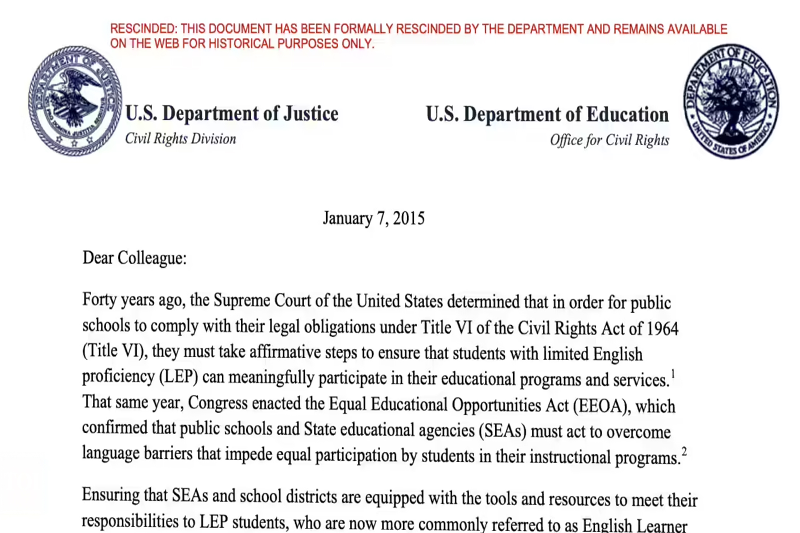
Trump Administration Rescinds English Learner Guidance, Leaving Millions of Students in Limbo
The Trump administration has officially rescinded federal guidance that for decades directed U.S. schools to support students learning English. The move, announced quietly by the Departments of Education and Justice, affects nearly 5 million students nationwide who are not yet fluent in English. Many of these students were born in the United States, but their educational future has been uncertain without federal oversight.
The change is part of a larger effort by the administration to make English the country’s “official language” while scaling back multilingual services across agencies. Education advocates warn that the decision could leave millions of children without critical support, reshaping how schools approach language learning nationwide.
A Shift Away from Longstanding Protections
For almost 50 years, federal law has held that schools must actively ensure non-English-speaking students can access meaningful education. This legal foundation was built on landmark rulings and legislation, including:
- Lau v. Nichols (1974): The U.S. Supreme Court held that failing to provide English language resources constitutes discrimination based on national origin under Title VI of the Civil Rights Act.
- The Equal Educational Opportunities Act (1974) required schools to overcome language barriers that prevent equal participation.
- Castañeda v. Pickard (1981): Clarified the standards schools must follow to support English learners adequately.
In 2015, under the Obama administration, the Justice and Education Departments released a 40-page guidance document that outlined specific steps schools could take to comply with these laws. It became a critical reference point for teachers and administrators nationwide. Montserrat Garibay, former head of the Office of English Language Acquisition under the Biden administration, described the document as “kind of like the Bible” for educators working with English learners.
This guidance has been labeled “rescinded” on the Education Department’s website, remaining online only “for historical purposes.” Department spokeswoman Madi Biedermann said the move was made because the guidance “is not in line with Administration policy.”
English Declared the Official Language
The policy change follows President Donald Trump’s March 1 executive order, formally declaring English the United States’ official language. In response, the Justice Department issued a memorandum directing all federal agencies to align with the order.
Attorney General Pam Bondi emphasized in the memo that treating students who are not proficient in English differently “does not on its face amount to discrimination based on national origin.” This marks a sharp departure from the legal interpretations that had guided federal oversight for decades.
The Education Department has since laid off most employees in its Office of English Language Acquisition and has requested Congress to terminate funding for the federal English learner support program. Several school districts, including Boston, Newark, and Worcester, Massachusetts, have already been released from federal monitoring of their English learner programs.
Concerns From Advocates
Civil rights groups, education advocates, and policy analysts are sounding the alarm. They argue that removing federal oversight and rescinding the guidance could weaken instruction for English learners and leave schools uncertain about their responsibilities.
Michael Pillera, attorney and director of the Educational Opportunities Project at the Lawyers Committee for Civil Rights, said:
“The Department of Education and the Department of Justice are walking away from 55 years of legal understanding and enforcement. I don’t think we can understate how important that is.”
Similarly, Leslie Villegas, an education policy analyst at New America, warned that the change could foster complacency in schools:
“The rescission of this guidance may create the mentality that no one’s watching.”
Advocates stress that districts may scale back services without clear federal direction, especially those already facing financial pressures. Depending on where they live, this could result in inconsistent support for millions of English learners.
Supporters Defend the Move
Not all reactions have been adverse. Supporters of the Trump administration’s decision argue that schools should prioritize rapid English immersion instead of investing heavily in multilingual programs.
Ira Mehlman, spokesperson for the Federation for American Immigration Reform, argued that resources spent on non-English speakers could hurt other students:
“If you devote all these resources to these kids coming in completely unprepared, inevitably it will diminish the quality of education others are getting.”
Todd DuBois of U.S. English echoed this view, claiming that multilingual instruction often delays English literacy:
“Multilingual instruction gets in the way of teaching English literacy earlier in life.”
These perspectives align with the administration’s push to promote assimilation and prioritize English-only instruction nationwide.
The Path Forward
The Trump administration insists the change is about consistency and efficiency. Its memo directs agencies to prioritize English instruction while clarifying when multilingual assistance may still be necessary. Pam Bondi described the effort as a push to “promote assimilation over division.”
Yet for many educators, the path forward is uncertain. Schools may diverge significantly in handling English learners without the federal guidance that once dictated best practices. Wealthier districts can sustain support programs, while underfunded districts struggle, leaving vulnerable students at risk of falling behind.
Garibay, who once oversaw English learner programs at the federal level, criticized the move sharply:
“Instead of providing this office with more capacity and resources to do exactly what the executive order says — to make sure that everybody speaks English — they are doing the opposite.”
Conclusion
The Trump administration's rescission of English learner guidance marks a historic reversal of decades-long federal oversight in education. While the administration frames the change as part of a broader push for national unity under a single language, critics warn it could undermine equal opportunity for millions of students.
The debate underscores a larger tension in American education: how to balance assimilation with diversity and ensure that every child—regardless of their first language—has the tools to succeed.
For now, school districts, teachers, and families of English learners face a future of uncertainty, navigating an education system without the federal guardrails that have guided it for generations.



